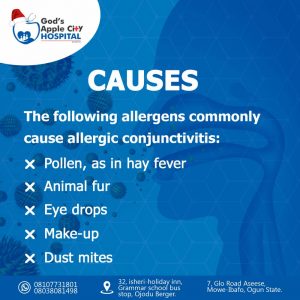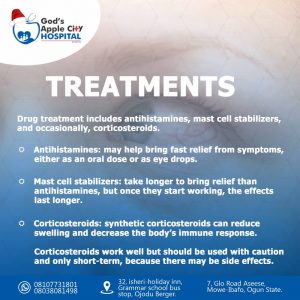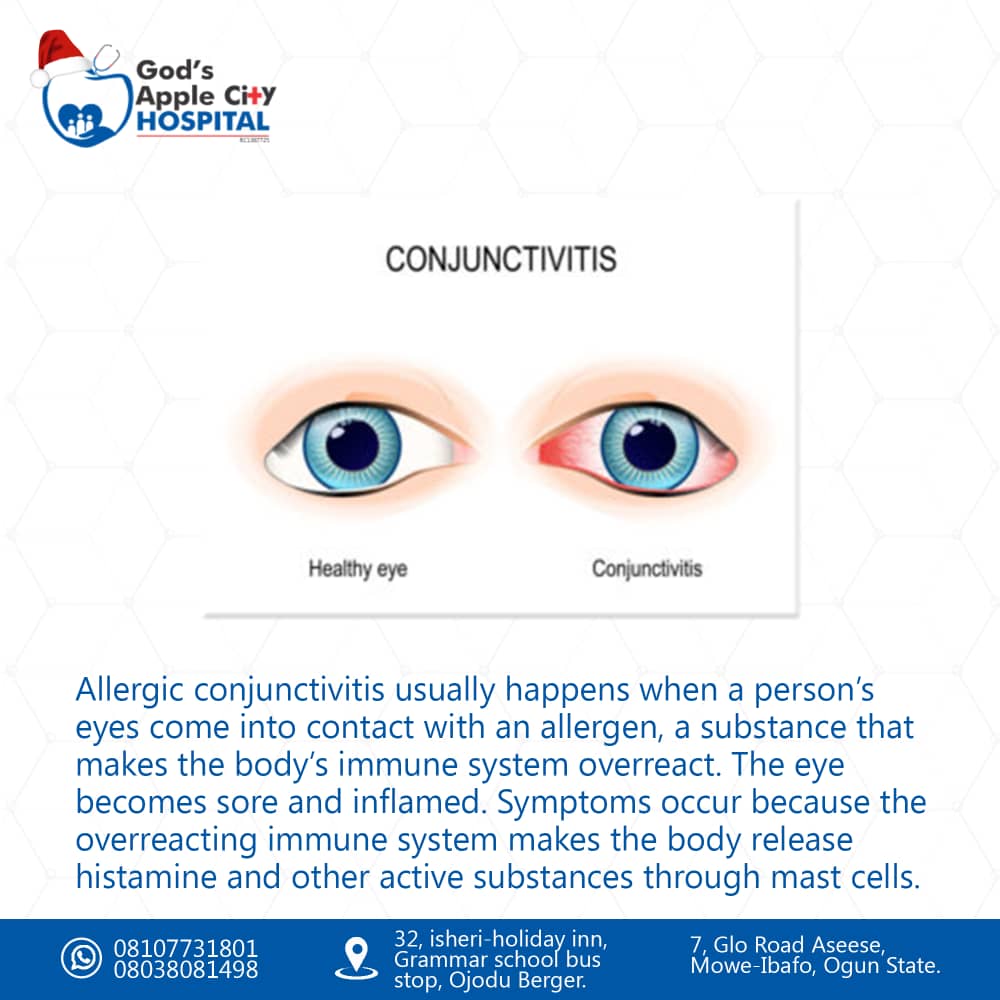Allergic conjunctivitis usually happens when a person’s eyes come into contact with an allergen, a substance that makes the body’s immune system overreact.
The eye becomes sore and inflamed. Symptoms occur because the overreacting immune system makes the body release histamine and other active substances through mast cells. The blood vessels dilate, or expand, and this irritates the nerve endings. The result is an increased secretion of tears.
Allergic conjunctivitis is different from infective conjunctivitis. The causes are different.

Types
There are different types of allergic conjunctivitis.
1) Seasonal allergic conjunctivitis or allergic rhinoconjunctivitis
Pollen is the most common allergen to cause conjunctivitis in countries that have cold winters.
If conjunctivitis results from pollen, there will likely be other symptoms, including sneezing, an itchy, blocked, or runny nose, and itchy and watery eyes.
Seasonal allergic conjunctivitis or allergic rhinoconjunctivitis is also known as hay fever.
It usually happens during the spring and summer months. At this time, plants, and especially grass, trees, and flowers, are in pollen. Some people have symptoms during early fall.
2) Contact conjunctivitis
Also known as contact dermatoconjunctivtis, symptoms are usually caused by cosmetics, eye-drops, or other chemicals that irritate the conjunctiva in those who are susceptible. Contact with these substances leads to an allergic response. Some people are sensitive to specific substances.
Symptoms usually develop 2 to 4 days after the substance comes into contact with the eyes.
3) Giant papillary conjunctivitis
This often results from wearing contact lenses. In some people, contact lenses cause discomfort. This can get progressively worse and increasingly uncomfortable, causing the eyes to become red.
Giant papillary conjunctivitis (GPC) may also occur when a person uses hard contact lenses after eye surgery.
Poor hygiene when handling contact lenses, solutions, and cases may contribute to infections of the eye.
4) Perennial conjunctivitis
Perennial conjunctivitis lasts all year. It mainly results from an allergy to house dust mites. These are microscopic insect-like creatures that live mainly in bedding, upholstered furniture, and carpets.
Dust mites eat skin cells shed by people, and they love warm, humid environments.
Dust-mite allergy is an immune-system response to a specific dust mite protein. This causes a range of problems, including conjunctivitis, a blocked or runny nose, sneezing, and contraction of the airways, as in asthma.
Other causes include animal dander, the small scales from animal skins or hair or bird feathers. These can cause an allergic reaction in some people.
Causes
An allergic reaction happens when the immune system overreacts to a substance. Most people do not react in this way to dust, pollen, and other substances, but some are more susceptible.
The following allergens commonly cause allergic conjunctivitis:
- Pollen, as in hay fever
- Animal fur
- Eye drops
- Make-up
- Dust mites

Symptoms
Most people with allergic conjunctivitis have problems with both eyes.
Symptoms may appear quickly, soon after the eyes come into contact with the allergen. In other cases, for example, if eye drops are causing a reaction, symptoms may appear after 2 to 4 days.
Symptoms of allergic conjunctivitis include:
- Red or pink eyes: The eyes become irritated as the capillaries, or small blood vessels, widen in the conjunctiva.
- Pain: This may affect one or both eyes. If a person has painful, red eyes, is sensitive to light, and their vision is affected, they should see a doctor at once.
- Itchiness: As the eyes are irritated, they may itch. Rubbing can make the itchiness worse.
- Swollen eyelids: The eyelids may puff up when the conjunctiva becomes inflamed, or if the person has been rubbing them a lot.
- Soreness: The inflammation may make the whole area feel sore and tender. Some people say the soreness feels like burning.
People with seasonal allergic conjunctivitis will experience symptoms at certain times during the year, usually from early spring into summer, and sometimes into fall.
Those with perennial allergic conjunctivitis are susceptible at any time of year. They may find symptoms are worse at certain times of the day than at others.
If the eyelids are red, cracked, or dry, this may indicate contact conjunctivitis. Contact conjunctivitis and giant papillary conjunctivitis are not seasonal, and symptoms may occur at any time of year.

Complications
Complications of perennial or seasonal allergic conjunctivitis are rare.
Allergic conjunctivitis can affect a person’s quality of life but does not normally have a long-term impact on health.
Complications can sometimes occur with dermatoconjunctivitis and giant papillary conjunctivitis.
The cornea may become inflamed. This is known as keratitis, and it can cause ulcers to form on the cornea. This increases the risk of scarring and the possibility of permanent vision loss.
Symptoms of keratitis are:
- intense pain in the eye
- sensitivity to light
- blurred vision
- a feeling that there is something in the eye
- watery eyes
If these symptoms occur, the person should see a doctor.
Prevention
The best way to prevent allergic rhinitis is to find out what is causing it and to avoid the allergen.
Common allergens are pet fur and pollen.
If the allergy is caused by pets, try the following:
- keep pets out of the bedroom
- brush them regularly and wash them every 2 weeks
- wash their bedding regularly
If you are visiting a house where there is a pet, taking an antihistamine medicine one hour before may help reduce symptoms.
If pollen causes a reaction:
- stay inside and keep doors and windows closed when the pollen count is high
- avoid areas with a lot of grass, flowers, or trees
- use wraparound sunglasses to protect your eyes
- bathe and change your clothes after being outside
- try to get someone else to cut the lawn for you
Mid-morning and early evening are when the pollen count is highest.
If house dust mites cause a reaction:
- avoid soft furnishings, such as carpets and drapes
- use a vacuum cleaner with a HEPA filter
- choose anti-allergenic matresses and bedding
- vacuum often, and dust with a clean, damp cloth
Treatment
The following may offer relief:
- Avoiding the allergen: Keeping the house clean, minimizing soft furnishings, and staying indoors when the pollen count is high can help.
- Artificial tears: These eye drops dilute the allergen and help remove it.
- Avoiding contact lenses: These should not be used until symptoms have completely disappeared. After using any medication on the eye, wait 24 hours after treatment has ended before wearing contact lenses.
- Refraining from rubbing the eyes: Rubbing can make the inflammation worse. This can be difficult, as it is tempting to rub itchy eyes.
- Cold compresses: Holding a wad of cotton wool soaked in cold water on the eyelid can soothe the eyes.
Drug treatment includes antihistamines, mast cell stabilizers, and occasionally, corticosteroids.
Antihistamines
Antihistamines may help bring fast relief from symptoms, either as an oral dose or as eye drops. Antihistamines block the effects of histamines. The body produces histamines when the immune system reacts to a foreign substance.
Oral antihistamines for allergic conjunctivitis are cetirizine, fexofenadine, and loratadine. These are usually taken once a day. Antihistamine eye drops include Alaway and Zaditor. . The eye drops will relieve symptoms in the eyes, but the oral dose will also help treat a runny nose and other symptoms.
The most commonly prescribed antihistamine eye drops include azelastine, emedastine, and ketotifen. They are applied to the eyes two or three times a day.
Some antihistamines may cause drowsiness. People taking them for the first time should refrain from driving or operating heavy machinery until they know whether or not the medication affects them.
Mast cell stabilizers
Mast cell stabilizers take longer to bring relief than antihistamines, but once they start working, the effects last longer.
The most popular mast cell stabilizers are lodoxamide and nedocromil. They come in the form of eye drops.
Some patients take both antihistamines and mast cell stabilizers. The antihistamines provide some relief from symptoms before the mast cell stabilizers start working.
Corticosteroids
These are rarely prescribed, and only if symptoms are severe. Corticoid is a steroid hormone produced by the adrenal cortex. As a medication, synthetic corticosteroids can reduce swelling and decrease the body’s immune response.
Corticosteroids work well but should be used with caution and only short-term, because there may be side effects.

Diagnosis
A doctor will diagnose allergic conjunctivitis by examining the patient and asking about signs and symptoms, including sneezing and a runny nose.
They may also need to rule out other conditions with similar symptoms.
Anyone with the following symptoms should see a doctor immediately, as they may have a more serious condition:
- Painful eyes
- Sensitivity to light, or photophobia
- Vision problems
- Very red eyes
Apart from allergic conjunctivitis, the eyes may become red with the following conditions:
- Infective conjunctivitis: This is caused by bacteria or virus. It can be linked to the herpes virus, and it may indicate a sexually transmitted infection (STI).
- Acute glaucoma: Pressure builds up in the eye. Symptoms can appear rapidly. Untreated, acute glaucoma can cause incurable vision loss.
- Keratitis: The cornea becomes inflamed and occasionally ulcerated. Sometimes it can progress to scarring of the cornea, resulting in permanent vision loss.
- Iritis: This is an inflammation of the iris. If left untreated, the iris may stick to the lens, preventing vital fluid drainage from the pupil. The result could be irreversible eye damage.
The doctor will also check whether some object or substance, such as an eyelash, may be causing the irritation.
If symptoms are severe or worsening, the doctor may refer the patient to an eye specialist, or ophthalmologist.
Anyone who develops papillary conjunctivitis after recent eye surgery will be referred to an ophthalmologist. The eye or eyes must be carefully monitored to ensure that treatment is effective.
.
.
.
.
.
.
.
.
.
.
https://web.facebook.com/Godsapplecity
read other blogs https://godsapplecityhospital.com/breast-cancer-signs-and-detection/

